Bernhard Schölkopf
MPI-IS
Generation is Required for Data-Efficient Perception
Dec 17, 2025Abstract:It has been hypothesized that human-level visual perception requires a generative approach in which internal representations result from inverting a decoder. Yet today's most successful vision models are non-generative, relying on an encoder that maps images to representations without decoder inversion. This raises the question of whether generation is, in fact, necessary for machines to achieve human-level visual perception. To address this, we study whether generative and non-generative methods can achieve compositional generalization, a hallmark of human perception. Under a compositional data generating process, we formalize the inductive biases required to guarantee compositional generalization in decoder-based (generative) and encoder-based (non-generative) methods. We then show theoretically that enforcing these inductive biases on encoders is generally infeasible using regularization or architectural constraints. In contrast, for generative methods, the inductive biases can be enforced straightforwardly, thereby enabling compositional generalization by constraining a decoder and inverting it. We highlight how this inversion can be performed efficiently, either online through gradient-based search or offline through generative replay. We examine the empirical implications of our theory by training a range of generative and non-generative methods on photorealistic image datasets. We find that, without the necessary inductive biases, non-generative methods often fail to generalize compositionally and require large-scale pretraining or added supervision to improve generalization. By comparison, generative methods yield significant improvements in compositional generalization, without requiring additional data, by leveraging suitable inductive biases on a decoder along with search and replay.
Scaling Behavior of Discrete Diffusion Language Models
Dec 11, 2025Abstract:Modern LLM pre-training consumes vast amounts of compute and training data, making the scaling behavior, or scaling laws, of different models a key distinguishing factor. Discrete diffusion language models (DLMs) have been proposed as an alternative to autoregressive language models (ALMs). However, their scaling behavior has not yet been fully explored, with prior work suggesting that they require more data and compute to match the performance of ALMs. We study the scaling behavior of DLMs on different noise types by smoothly interpolating between masked and uniform diffusion while paying close attention to crucial hyperparameters such as batch size and learning rate. Our experiments reveal that the scaling behavior of DLMs strongly depends on the noise type and is considerably different from ALMs. While all noise types converge to similar loss values in compute-bound scaling, we find that uniform diffusion requires more parameters and less data for compute-efficient training compared to masked diffusion, making them a promising candidate in data-bound settings. We scale our uniform diffusion model up to 10B parameters trained for $10^{22}$ FLOPs, confirming the predicted scaling behavior and making it the largest publicly known uniform diffusion model to date.
A Critical Perspective on Finite Sample Conformal Prediction Theory in Medical Applications
Dec 09, 2025Abstract:Machine learning (ML) is transforming healthcare, but safe clinical decisions demand reliable uncertainty estimates that standard ML models fail to provide. Conformal prediction (CP) is a popular tool that allows users to turn heuristic uncertainty estimates into uncertainty estimates with statistical guarantees. CP works by converting predictions of a ML model, together with a calibration sample, into prediction sets that are guaranteed to contain the true label with any desired probability. An often cited advantage is that CP theory holds for calibration samples of arbitrary size, suggesting that uncertainty estimates with practically meaningful statistical guarantees can be achieved even if only small calibration sets are available. We question this promise by showing that, although the statistical guarantees hold for calibration sets of arbitrary size, the practical utility of these guarantees does highly depend on the size of the calibration set. This observation is relevant in medical domains because data is often scarce and obtaining large calibration sets is therefore infeasible. We corroborate our critique in an empirical demonstration on a medical image classification task.
Tracing Multilingual Representations in LLMs with Cross-Layer Transcoders
Nov 13, 2025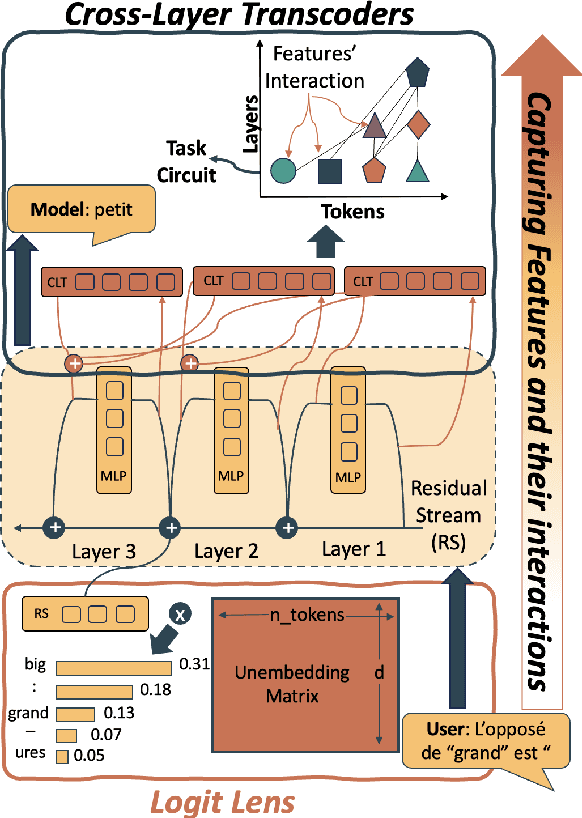
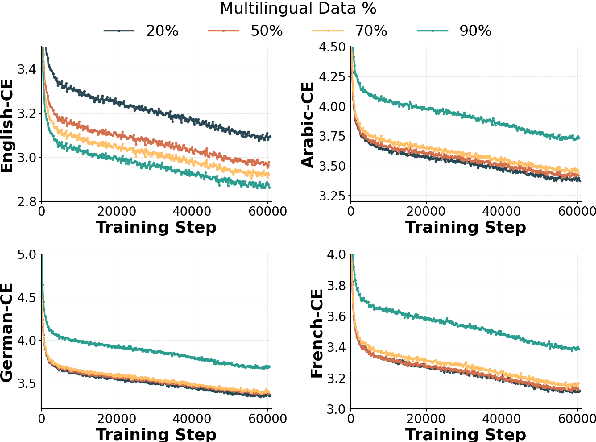
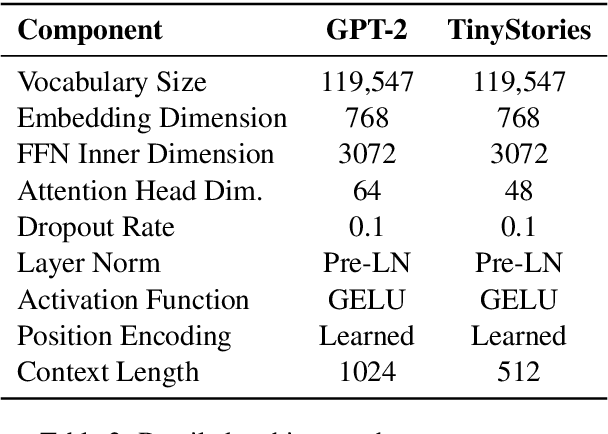
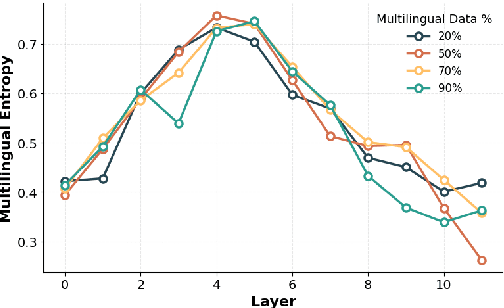
Abstract:Multilingual Large Language Models (LLMs) can process many languages, yet how they internally represent this diversity remains unclear. Do they form shared multilingual representations with language-specific decoding, and if so, why does performance still favor the dominant training language? To address this, we train a series of LLMs on different mixtures of multilingual data and analyze their internal mechanisms using cross-layer transcoders (CLT) and attribution graphs. Our results provide strong evidence for pivot language representations: the model employs nearly identical representations across languages, while language-specific decoding emerges in later layers. Attribution analyses reveal that decoding relies in part on a small set of high-frequency language features in the final layers, which linearly read out language identity from the first layers in the model. By intervening on these features, we can suppress one language and substitute another in the model's outputs. Finally, we study how the dominant training language influences these mechanisms across attribution graphs and decoding pathways. We argue that understanding this pivot-language mechanism is crucial for improving multilingual alignment in LLMs.
TabPFN-2.5: Advancing the State of the Art in Tabular Foundation Models
Nov 11, 2025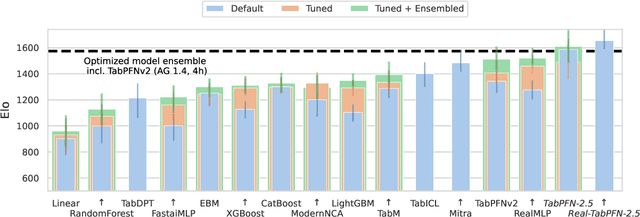

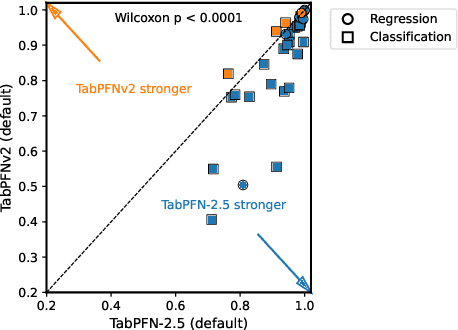
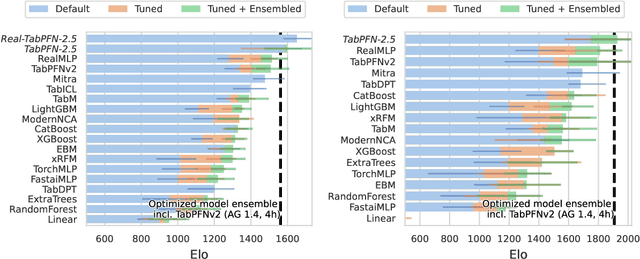
Abstract:The first tabular foundation model, TabPFN, and its successor TabPFNv2 have impacted tabular AI substantially, with dozens of methods building on it and hundreds of applications across different use cases. This report introduces TabPFN-2.5, the next generation of our tabular foundation model, built for datasets with up to 50,000 data points and 2,000 features, a 20x increase in data cells compared to TabPFNv2. TabPFN-2.5 is now the leading method for the industry standard benchmark TabArena (which contains datasets with up to 100,000 training data points), substantially outperforming tuned tree-based models and matching the accuracy of AutoGluon 1.4, a complex four-hour tuned ensemble that even includes the previous TabPFNv2. Remarkably, default TabPFN-2.5 has a 100% win rate against default XGBoost on small to medium-sized classification datasets (<=10,000 data points, 500 features) and a 87% win rate on larger datasets up to 100K samples and 2K features (85% for regression). For production use cases, we introduce a new distillation engine that converts TabPFN-2.5 into a compact MLP or tree ensemble, preserving most of its accuracy while delivering orders-of-magnitude lower latency and plug-and-play deployment. This new release will immediately strengthen the performance of the many applications and methods already built on the TabPFN ecosystem.
PENEX: AdaBoost-Inspired Neural Network Regularization
Oct 02, 2025Abstract:AdaBoost sequentially fits so-called weak learners to minimize an exponential loss, which penalizes mislabeled data points more severely than other loss functions like cross-entropy. Paradoxically, AdaBoost generalizes well in practice as the number of weak learners grows. In the present work, we introduce Penalized Exponential Loss (PENEX), a new formulation of the multi-class exponential loss that is theoretically grounded and, in contrast to the existing formulation, amenable to optimization via first-order methods. We demonstrate both empirically and theoretically that PENEX implicitly maximizes margins of data points. Also, we show that gradient increments on PENEX implicitly parameterize weak learners in the boosting framework. Across computer vision and language tasks, we show that PENEX exhibits a regularizing effect often better than established methods with similar computational cost. Our results highlight PENEX's potential as an AdaBoost-inspired alternative for effective training and fine-tuning of deep neural networks.
Orthogonal Finetuning Made Scalable
Jun 24, 2025Abstract:Orthogonal finetuning (OFT) offers highly parameter-efficient adaptation while preventing catastrophic forgetting, but its high runtime and memory demands limit practical deployment. We identify the core computational bottleneck in OFT as its weight-centric implementation, which relies on costly matrix-matrix multiplications with cubic complexity. To overcome this, we propose OFTv2, an input-centric reformulation that instead uses matrix-vector multiplications (i.e., matrix-free computation), reducing the computational cost to quadratic. We further introduce the Cayley-Neumann parameterization, an efficient orthogonal parameterization that approximates the matrix inversion in Cayley transform via a truncated Neumann series. These modifications allow OFTv2 to achieve up to 10x faster training and 3x lower GPU memory usage without compromising performance. In addition, we extend OFTv2 to support finetuning quantized foundation models and show that it outperforms the popular QLoRA in training stability, efficiency, and memory usage.
Democratic or Authoritarian? Probing a New Dimension of Political Biases in Large Language Models
Jun 15, 2025Abstract:As Large Language Models (LLMs) become increasingly integrated into everyday life and information ecosystems, concerns about their implicit biases continue to persist. While prior work has primarily examined socio-demographic and left--right political dimensions, little attention has been paid to how LLMs align with broader geopolitical value systems, particularly the democracy--authoritarianism spectrum. In this paper, we propose a novel methodology to assess such alignment, combining (1) the F-scale, a psychometric tool for measuring authoritarian tendencies, (2) FavScore, a newly introduced metric for evaluating model favorability toward world leaders, and (3) role-model probing to assess which figures are cited as general role-models by LLMs. We find that LLMs generally favor democratic values and leaders, but exhibit increases favorability toward authoritarian figures when prompted in Mandarin. Further, models are found to often cite authoritarian figures as role models, even outside explicit political contexts. These results shed light on ways LLMs may reflect and potentially reinforce global political ideologies, highlighting the importance of evaluating bias beyond conventional socio-political axes. Our code is available at: https://github.com/irenestrauss/Democratic-Authoritarian-Bias-LLMs
Improving Large Language Model Safety with Contrastive Representation Learning
Jun 13, 2025Abstract:Large Language Models (LLMs) are powerful tools with profound societal impacts, yet their ability to generate responses to diverse and uncontrolled inputs leaves them vulnerable to adversarial attacks. While existing defenses often struggle to generalize across varying attack types, recent advancements in representation engineering offer promising alternatives. In this work, we propose a defense framework that formulates model defense as a contrastive representation learning (CRL) problem. Our method finetunes a model using a triplet-based loss combined with adversarial hard negative mining to encourage separation between benign and harmful representations. Our experimental results across multiple models demonstrate that our approach outperforms prior representation engineering-based defenses, improving robustness against both input-level and embedding-space attacks without compromising standard performance. Our code is available at https://github.com/samuelsimko/crl-llm-defense
Flipping Against All Odds: Reducing LLM Coin Flip Bias via Verbalized Rejection Sampling
Jun 11, 2025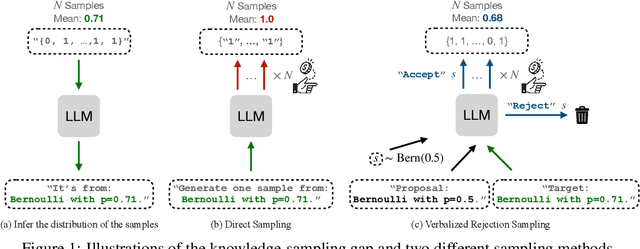

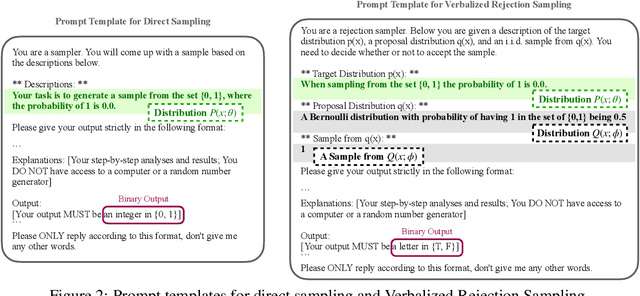
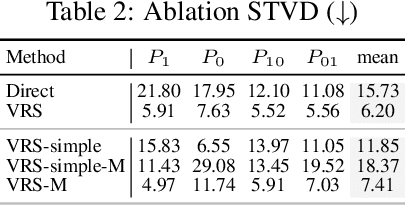
Abstract:Large language models (LLMs) can often accurately describe probability distributions using natural language, yet they still struggle to generate faithful samples from them. This mismatch limits their use in tasks requiring reliable stochasticity, such as Monte Carlo methods, agent-based simulations, and randomized decision-making. We investigate this gap between knowledge and sampling in the context of Bernoulli distributions. We introduce Verbalized Rejection Sampling (VRS), a natural-language adaptation of classical rejection sampling that prompts the LLM to reason about and accept or reject proposed samples. Despite relying on the same Bernoulli mechanism internally, VRS substantially reduces sampling bias across models. We provide theoretical analysis showing that, under mild assumptions, VRS improves over direct sampling, with gains attributable to both the algorithm and prompt design. More broadly, our results show how classical probabilistic tools can be verbalized and embedded into LLM workflows to improve reliability, without requiring access to model internals or heavy prompt engineering.
 Add to Chrome
Add to Chrome Add to Firefox
Add to Firefox Add to Edge
Add to Edge